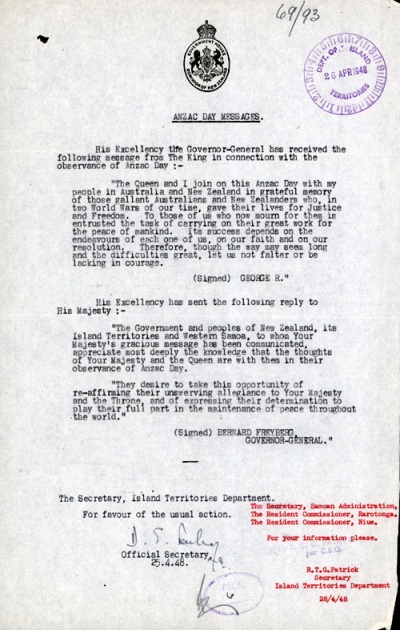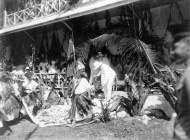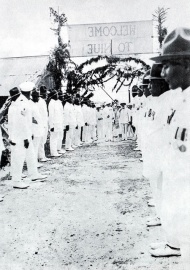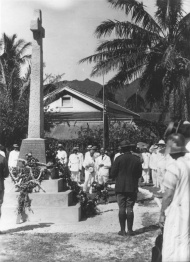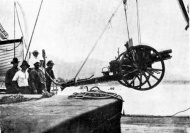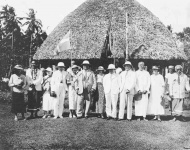Articles
New Zealand in Samoa

New Zealand was ill-equipped to cope with the Western Samoa mandate allocated by the League of Nations in 1920. The Mau movement's passive resistance culminated in the violence of 'Black Saturday', 28 December 1929, which left 11 Samoans and one New Zealand policeman dead.
-
Page 2 – Background
When war broke out in Europe in August 1914, Britain asked New Zealand to seize German Samoa as a 'great and urgent Imperial service'.
-
Page 4 – Sowing seeds of discontent
By 1926, anti-New Zealand feeling was strong throughout Samoa.
-
Page 5 – The rise of the Mau movement
Samoa has a history of opposition to European rule, but the opposition that emerged in the late 1920s was organised and widespread.
-
Page 6 – Stepping up the Mau campaign
In January 1928 Mau policeman, dressed in a uniform of a purple lavalava with a white stripe, began enforcing a sā - ban - on European stores in Apia.
-
Page 7 – Black Saturday
One New Zealand policeman and up to 11 Samoans, including Tupua Tamasese Lealofi III, were killed in Apia on Black Saturday - 28 December 1929.
-
Page 8 – Towards independence
On 4 June 2002 Prime Minister Helen Clark offered 'a formal apology to the people of Samoa for the injustices arising from New Zealand's administration of Samoa in its earlier
Pacific aftermath

Participation in the First World War changed Pacific Islanders' lives. Returning servicemen had seen the world.
-
Page 2 – Peace celebrations in the Pacific
News of the Armistice in Europe in November 1918 came swiftly to Rarotonga via its new wireless station.
-
Page 3 – Troop repatriation
When the Armistice was signed in November 1918, Pacific island troops in New Zealand service were stationed in a number of locations.
-
Page 4 – NZ government acknowledgement
During the 1920s, the contribution of the Cook Islands and Niue to the war effort was recognised in a number of ways, especially official visits, the building of monuments and
-
Page 5 – Economic, social and political impact
The First World War opened the Pacific Islands to the world more than they ever had been before.
Anzac Day in the Pacific

Armistice Day was the initial focal point for commemorations in the Cook Islands and Niue after the First World War. But because men from both countries had served in the New Zealand Expeditionary Force, observances gradually shifted to Anzac Day in April
-
Page 2 – Early commemorative efforts
During the 1920s war memorials provided a focus for commemoration services in the Cook Islands, where the first Anzac Day service was possibly held in 1927. On Niue, Armistice
-
Page 3 – The growth of Anzac Day
By the end of the Second World War military commemorations in the Cook Islands and Niue centered around Anzac Day. Services in both countries followed the pattern of those in
-
Page 4 – Present day commemorations
In the new millennium there has been increasing interest in the story of Pacific Island involvement in the First World War. In the Cook Islands there have been efforts to
-
Page 5 – Further information
Books and further reading relating to the history of Anzac Day in the Pacific Islands of Niue and the Cook Islands
Pacific Islanders in the NZEF

Cook Islanders, Niueans, Fijians and Gilbert Islanders all took their place in the ranks of the New Zealand Expeditionary Force during the First World War. As well as the dangers of war, Pacific soldiers faced language difficulties, an unfamiliar army diet and European diseases.
-
Page 2 – Niueans and Cook Islanders
Information about Niuean and Cook Island soldiers who were part of the 3rd Maori Contingent of Reinforcements in 1916.
-
Page 3 – The Rarotongan Company
Information on the New Zealand Rarotongan Company, which served in the Sinai and Palestine campaigns 1916-18.
-
Page 4 – Fijian and Gilbert Island Contingents
Information on men from Fiji and the Gilbert Islands who enlisted for service in the NZEF.
-
Page 5 – Difficulties faced by Pacific Islanders
Information on the difficulties faced by Pacific Islanders when they left their island homes for the first time and entered the army.
-
Page 7 – Further information
Further reading and links to more information about Pacific Islanders in the NZEF during the First World War.
Capture of German Samoa

When war broke out in Europe in August 1914, Britain asked New Zealand to seize German Samoa as a ‘great and urgent Imperial service’. Although the tiny German garrison offered no opposition, at the time it was regarded as a potentially risky action.
-
Page 3 – Seizing German Samoa
With hindsight, New Zealand's capture of German Samoa on 29 August 1914 was an easy affair. But at the time it was regarded as a potentially risky action with uncertain
-
Page 4 – Wartime administration
German officials were replaced by New Zealand military officers, civilians, or British residents. These often lacked the experience or qualifications to do the job.
State housing

New Zealand's first state house was formally opened on 18 September 1937. But the government has provided rental housing for New Zealanders for more than a century. Explore the history of this country's various state housing schemes and their contribution to the New Zealand way of life.
- Page 6 - Making ends meetFor low-paid workers and beneficiaries, making ends meet has always been a constant struggle. Life can be even tougher for those without a home of their
Related keywords
- WW1
- anzac day
- cook islands
- niue
- war memorials
- cemeteries
- royalty
- dawn service
- public holidays
- RSA
- rarotonga
- memorials
- lord liverpool
- james allen
- charles fergusson
- medals
- armistice
- peace celebrations
- rarotongan company
- fiji
- gilbert islands
- influenza pandemic
- shipping
- parliament buildings
- panorama
- narrow neck camp
- disease
- language
- clothing
- samoa
- german samoa occupation
- robert logan
- mau movement
- olaf nelson
- maui pomare
- western front
- health
- pioneer battalion
- economy
- palestine campaign
- sinai campaign
- british empire
- international relations
- league of nations
- protest
- 1920s
- police
- german navy
- maori in war
- labour party
- united nations
- helen clark
- nurses
- radio broadcasts
- maori
- housing
- state housing
- families
- poverty
- maori housing
- women
- richard seddon
- WW1 stories
- funerals
- tonga
- roll of honour
- cartoon
- race relations
- postcard
- international trade
-
Main image: The King's Anzac Day message, 1948
King George VI's Anzac Day message, 1948

